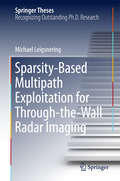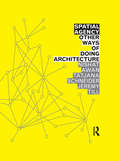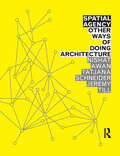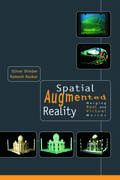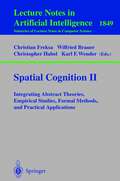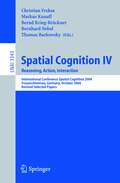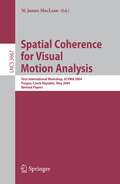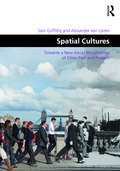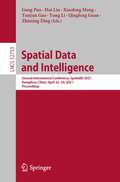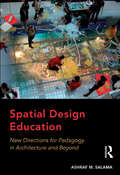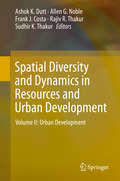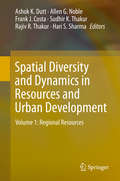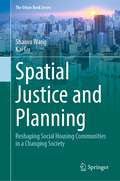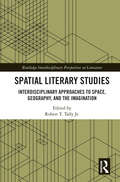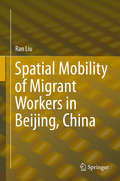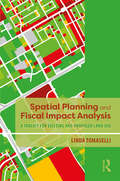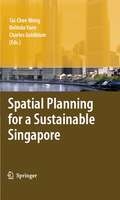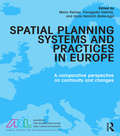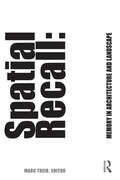- Table View
- List View
Sparsity-Based Multipath Exploitation for Through-the-Wall Radar Imaging (Springer Theses)
by Michael LeigsneringThis thesis reports on sparsity-based multipath exploitation methods for through-the-wall radar imaging. Multipath creates ambiguities in the measurements provoking unwanted ghost targets in the image. This book describes sparse reconstruction methods that are not only suppressing the ghost targets, but using multipath to one’s advantage. With adopting the compressive sensing principle, fewer measurements are required for image reconstruction as compared to conventional techniques. The book describes the development of a comprehensive signal model and some associated reconstruction methods that can deal with many relevant scenarios, such as clutter from building structures, secondary reflections from interior walls, as well as stationary and moving targets, in urban radar imaging. The described methods are evaluated here using simulated as well as measured data from semi-controlled laboratory experiments.
Spatial Agency: Other Ways of Doing Architecture
by Nishat Awan Tatjana Schneider Jeremy TillThis book offers the first comprehensive overview of alternative approaches to architectural practice. At a time when many commentators are noting that alternative and richer approaches to architectural practice are required if the profession is to flourish, this book provides multiple examples from across the globe of how this has been achieved and how it might be achieved in the future. Particularly pertinent in the current economic climate, this book offers the reader new approaches to architectural practice in a changing world. It makes essential reading for any architect, aspiring or practicing.
Spatial Agency: Other Ways of Doing Architecture
by Nishat Awan Tatjana Schneider Jeremy TillThis book offers the first comprehensive overview of alternative approaches to architectural practice. At a time when many commentators are noting that alternative and richer approaches to architectural practice are required if the profession is to flourish, this book provides multiple examples from across the globe of how this has been achieved and how it might be achieved in the future. Particularly pertinent in the current economic climate, this book offers the reader new approaches to architectural practice in a changing world. It makes essential reading for any architect, aspiring or practicing.
Spatial Augmented Reality: Merging Real and Virtual Worlds
by Oliver Bimber Ramesh RaskarLike virtual reality, augmented reality is becoming an emerging platform in new application areas for museums, edutainment, home entertainment, research, industry, and the art communities using novel approaches which have taken augmented reality beyond traditional eye-worn or hand-held displays. In this book, the authors discuss spatial augmented r
Spatial Cognition II: Integrating Abstract Theories, Empirical Studies, Formal Methods, and Practical Applications (Lecture Notes in Computer Science #1849)
by Christian Freksa Wilfried Brauer Christopher Habel Karl F. WenderSpatial Cognition IV, Reasoning, Action, Interaction: International Spatial Cognition 2004, Frauenchiemsee, Germany, October 11-13, 2004, Revised Selected Papers (Lecture Notes in Computer Science #3343)
by Christian Freksa Markus Knauff Bernd Krieg-Brückner Bernhard Nebel Thomas BarkowskyThis is the fourth volume in a series of books dedicated to basic research in spatial cognition. Spatial cognition is a field that investigates the connection between the physical spatial world and the mental world. Philosophers and researchers have p- posed various views concerning the relation between the physical and the mental worlds: Plato considered pure concepts of thought as separate from their physical manifestations while Aristotle considered the physical and the mental realms as two aspects of the same substance. Descartes, a dualist, discussed the interaction between body and soul through an interface organ and thus introduced a functional view that presented a challenge for the natural sciences and the humanities. In modern psych- ogy, the relation between the physical and the cognitive space has been investigated using thorough experiments, and in artificial intelligence we have seen views as diverse as ‘problems can be solved on a representation of the world’ and ‘a representation of the world is not necessary. ’ Today’s spatial cognition work establishes a correspondence between the mental and the physical worlds by studying and exploiting their interaction; it investigates how mental space and spatial “reality” join together in understanding the world and in interacting with it. The physical and representational aspects are equally important in this work. Almost all topics of cognitive science manifest themselves in spatial cognition.
Spatial Coherence for Visual Motion Analysis: First International Workshop, SCVMA 2004, Prague, Czech Republic, May 15, 2004, Revised Papers (Lecture Notes in Computer Science #3667)
by W. James MacLeanThis book constitutes the thoroughly refereed post-proceedings of the First International Workshop on Spatial Coherence for Visual Motion Analysis, 2004, held in May 2004. The eleven revised full research papers presented went through two rounds of reviewing and improvement. The papers in this volume cover a wide range in the field of motion analysis that is a central problem in computer vision. The workshop examined techniques for integrating spatial coherence constraints during motion analysis of image sequences.
Spatial Cultures: Towards a New Social Morphology of Cities Past and Present (Design and the Built Environment)
by Sam Griffiths Alexander Von LünenWhat is the relationship between how cities work and what cities mean? Spatial Cultures: Towards a New Social Morphology of Cities Past and Present announces an innovative research agenda for urban studies in which themes and methods from urban history, social theory and built environment research are brought into dialogue across disciplinary and chronological boundaries. The collection confronts the recurrent epistemological impasse that arises between research focussing on the description of material built environments and that which is concerned primarily with the people who inhabit, govern and write about cities past and present. A reluctance to engage substantively with this issue has been detrimental to scholarly efforts to understand the urban built environment as a meaningful agent of human social experience. Drawing on a wide range of historical and contemporary urban case studies, as well as a selection of theoretical and methodological reflections, the contributions to this volume seek to historically, geographically and architecturally contextualize diverse spatial practices including movement, encounter, play, procession and neighbourhood. The aim is to challenge their tacit treatment as universal categories in much writing on cities and to propose alternative research possibilities with implications as much for urban design thinking as for history and the social sciences.
Spatial Cultures: Towards a New Social Morphology of Cities Past and Present (Design and the Built Environment)
by Sam Griffiths Alexander Von LünenWhat is the relationship between how cities work and what cities mean? Spatial Cultures: Towards a New Social Morphology of Cities Past and Present announces an innovative research agenda for urban studies in which themes and methods from urban history, social theory and built environment research are brought into dialogue across disciplinary and chronological boundaries. The collection confronts the recurrent epistemological impasse that arises between research focussing on the description of material built environments and that which is concerned primarily with the people who inhabit, govern and write about cities past and present. A reluctance to engage substantively with this issue has been detrimental to scholarly efforts to understand the urban built environment as a meaningful agent of human social experience. Drawing on a wide range of historical and contemporary urban case studies, as well as a selection of theoretical and methodological reflections, the contributions to this volume seek to historically, geographically and architecturally contextualize diverse spatial practices including movement, encounter, play, procession and neighbourhood. The aim is to challenge their tacit treatment as universal categories in much writing on cities and to propose alternative research possibilities with implications as much for urban design thinking as for history and the social sciences.
Spatial Data and Intelligence: Second International Conference, SpatialDI 2021, Hangzhou, China, April 22–24, 2021, Proceedings (Lecture Notes in Computer Science #12753)
by Gang Pan Hui Lin Xiaofeng Meng Yunjun Gao Yong Li Qingfeng Guan Zhiming DingThis book constitutes the proceedings of the Second International Conference on Spatial Data and Intelligence, SpatialDI 2021, which was held during April 22-24, 2021 in Hangzhou, China.The 14 full papers and 7 short papers presented in this volume were carefully reviewed and selected from 72 submissions. They are organized in the topical sections named: traffic management, data science, and city analysis.
Spatial Design Education: New Directions for Pedagogy in Architecture and Beyond
by Ashraf M. SalamaDesign education in architecture and allied disciplines is the cornerstone of design professions that contribute to shaping the built environment of the future. In this book, design education is dealt with as a paradigm whose evolutionary processes, underpinning theories, contents, methods, tools, are questioned and critically examined. It features a comprehensive discussion on design education with a focus on the design studio as the backbone of that education and the main forum for creative exploration and interaction, and for knowledge acquisition, assimilation, and reproduction. Through international and regional surveys, the striking qualities of design pedagogy, contemporary professional challenges and the associated sociocultural and environmental needs are identified. Building on twenty-five years of research and explorations into design pedagogy in architecture and urban design, this book authoritatively offers a critical analysis of a continuously evolving profession, its associated societal processes and the way in which design education reacts to their demands. Matters that pertain to traditional pedagogy, its characteristics and the reactions developed against it in the form of pioneering alternative studio teaching practices. Advances in design approaches and methods are debated including critical inquiry, empirical making, process-based learning, and Community Design, Design-Build, and Live Project Studios. Innovative teaching practices in lecture-based and introductory design courses are identified and characterized including inquiry-based, active and experiential learning. These investigations are all interwoven to elucidate a comprehensive understanding of contemporary design education in architecture and allied disciplines. A wide spectrum of teaching approaches and methods is utilized to reveal a theory of a ’trans-critical’ pedagogy that is conceptualized to shape a futuristic thinking about design teaching. Lessons learned from techniques
Spatial Design Education: New Directions for Pedagogy in Architecture and Beyond
by Ashraf M. SalamaDesign education in architecture and allied disciplines is the cornerstone of design professions that contribute to shaping the built environment of the future. In this book, design education is dealt with as a paradigm whose evolutionary processes, underpinning theories, contents, methods, tools, are questioned and critically examined. It features a comprehensive discussion on design education with a focus on the design studio as the backbone of that education and the main forum for creative exploration and interaction, and for knowledge acquisition, assimilation, and reproduction. Through international and regional surveys, the striking qualities of design pedagogy, contemporary professional challenges and the associated sociocultural and environmental needs are identified. Building on twenty-five years of research and explorations into design pedagogy in architecture and urban design, this book authoritatively offers a critical analysis of a continuously evolving profession, its associated societal processes and the way in which design education reacts to their demands. Matters that pertain to traditional pedagogy, its characteristics and the reactions developed against it in the form of pioneering alternative studio teaching practices. Advances in design approaches and methods are debated including critical inquiry, empirical making, process-based learning, and Community Design, Design-Build, and Live Project Studios. Innovative teaching practices in lecture-based and introductory design courses are identified and characterized including inquiry-based, active and experiential learning. These investigations are all interwoven to elucidate a comprehensive understanding of contemporary design education in architecture and allied disciplines. A wide spectrum of teaching approaches and methods is utilized to reveal a theory of a ’trans-critical’ pedagogy that is conceptualized to shape a futuristic thinking about design teaching. Lessons learned from techniques
Spatial Diversity and Dynamics in Resources and Urban Development: Volume II: Urban Development
by Ashok K. Dutt Allen G. Noble Frank J. Costa Rajiv R. Thakur Sudhir K. ThakurThis double-volume work focuses on socio-demographics and the use of such data to support strategic resource management and planning initiatives. Papers go beyond explanations of methods, technique and traditional applications to explore new intersections in the dynamic relationship between the utilization and management of resources, and urban development.International authors explore numerous experiences, characteristics of development and decision-making influences from across Asia and Southeast Asia, as well as recounting examples from America and Africa. Papers propound techniques and methods used in geographical research such as support vector machines, socio-economic correlates and travel behaviour analysis.In this volume the contributors examine cutting-edge theories explaining diversity and dynamics in urban development. Topics covered include human vulnerability to hazards, space and urban problematic, assessment and evaluation of regional urban systems and structures and urban transformations as a result of structural change, economic development and underdevelopment. The significance of these topics lie in the pace and volume of change as is happening in geography reflecting continued development within established fields of inquiry and the introduction of significantly new approaches during the last decade.Readers are invited to consider the dynamics of spatial expansion of urban areas and economic development, and to explore conceptual discussion of the innovations in and challenges on urbanization processes, urban spaces themselves and both resource management and environmental management.Together, the two volumes contribute to the interdisciplinary literature on regional resources and urban development by collating recent research with geography at its core. Scholars of urban geography, human geography, urbanism and sustainable development will be particularly interested in this book.
Spatial Diversity and Dynamics in Resources and Urban Development: Volume 1: Regional Resources
by Ashok K. Dutt Allen G. Noble Frank J. Costa Sudhir K. Thakur Rajiv Thakur Hari S. SharmaThis double-volume work focuses on socio-demographics and the use of such data to support strategic resource management and planning initiatives. Papers go beyond explanations of methods, technique and traditional applications to explore new intersections in the dynamic relationship between the utilization and management of resources, and urban development.International authors explore numerous experiences, characteristics of development and decision-making influences from across Asia and Southeast Asia, as well as recounting examples from America and Africa. Papers propound techniques and methods used in geographical research such as support vector machines, socio-economic correlates and travel behaviour analysis.In this volume the contributions examine issues such as natural resource and environmental management, livelihoods issues in the context of climate change, land markets and land trusts, adaptive management of wildlife sanctuaries, ground water scarcity, flood hazards and flood plain management, non-conventional energy resources, community forestry and management and land use and land cover change. The significance of these topics lie in the pace and volume of change as is reflected through continued development within established fields of inquiry and the introduction of significantly new approaches during the last decade.Readers are invited to consider the dynamics of spatial expansion of urban areas and economic development, and to explore conceptual discussion of the innovations in and challenges on urbanization processes, urban spaces themselves and both resource management and environmental management.Together, the two volumes contribute to the interdisciplinary literature on regional resources and urban development by collating recent research with geography at its core. Scholars of urban geography, human geography, urbanism and sustainable development will be particularly interested in this book.
Spatial Justice and Planning: Reshaping Social Housing Communities in a Changing Society (The Urban Book Series)
by Shaoxu Wang Kai GuDespite the significance of urban justice in planning research and practice, how just societies and cities can be organised and achieved remains contested. Spatial justice provides an integrative and unifying theory concerning place, policies, people and their interplay, but ambiguities about its practical bases have undermined its application in planning. Through creating and substantiating a new conceptual framework comprising a morphological study, policy analysis and embodiment research, this book crystallises the spatiality of (in)justice and (in)justice of spatiality in the context of social housing redevelopment.Like many countries around the world, social housing in Aotearoa New Zealand is an area of contention, especially at the building and redevelopment stages. Protecting community character and human rights has been used by social housing tenants to resist changes, but the primary focus on material outcomes neglects broadening access to planning processes. Compact, mixed tenure and sustainable (re)developments are regarded as the just built environment, as they enable equal accessibility to all. But there are contradictions between the planned spatiality of justice and individuals’ socialised sensory space. Reconciliation of morphological differentiations in built forms and social cohesion remains a challenging task. This book focuses on the re-examination, integration and transferability of spatial justice. It makes a new contribution to urban justice theory by strengthening spatial justice and planning. Social housing areas are expected to adapt to changing social and economic demands while retaining much-valued established community character. This book also provides practical strategies for tackling complex planning problems in social housing redevelopment.
Spatial Literary Studies: Interdisciplinary Approaches to Space, Geography, and the Imagination (Routledge Interdisciplinary Perspectives on Literature)
by Robert T. Tally Jr.Following the spatial turn in the humanities and social sciences, Spatial Literary Studies: Interdisciplinary Approaches to Space, Geography, and the Imagination offers a wide range of essays that reframe or transform contemporary criticism by focusing attention, in various ways, on the dynamic relations among space, place, and literature. These essays reflect upon the representation of space and place, whether in the real world, in imaginary universes, or in those hybrid zones where fiction meets reality. Working within or alongside related approaches, such as geocriticism, literary geography, and the spatial humanities, these essays examine the relationship between literary spatiality and different genres or media, such as film or television. The contributors to Spatial Literary Studies draw upon diverse critical and theoretical traditions in disclosing, analyzing, and exploring the significance of space, place, and mapping in literature and in the world, thus making new textual geographies and literary cartographies possible.
Spatial Literary Studies: Interdisciplinary Approaches to Space, Geography, and the Imagination (Routledge Interdisciplinary Perspectives on Literature)
by Robert T. Tally Jr.Following the spatial turn in the humanities and social sciences, Spatial Literary Studies: Interdisciplinary Approaches to Space, Geography, and the Imagination offers a wide range of essays that reframe or transform contemporary criticism by focusing attention, in various ways, on the dynamic relations among space, place, and literature. These essays reflect upon the representation of space and place, whether in the real world, in imaginary universes, or in those hybrid zones where fiction meets reality. Working within or alongside related approaches, such as geocriticism, literary geography, and the spatial humanities, these essays examine the relationship between literary spatiality and different genres or media, such as film or television. The contributors to Spatial Literary Studies draw upon diverse critical and theoretical traditions in disclosing, analyzing, and exploring the significance of space, place, and mapping in literature and in the world, thus making new textual geographies and literary cartographies possible.
Spatial Mobility of Migrant Workers in Beijing, China
by Ran LiuThe great migration of farmers leaving rural China to work and live in big cities as 'floaters' has been an on-going debate in China for the past three decades. This book probes into the spatial mobility of migrant workers in Beijing, and questions the city 'rights' issues beneath the city-making movement in contemporary China. In revealing and explaining the socio-spatial injustice, this volume re-theorizes the 'right to the city' in the Chinese context since Deng Xiaoping's reforms. The policy review, census analysis, and housing survey are conducted to examine the fate of migrant workers, who being the most marginalized group have to move persistently as the city expands and modernizes itself. The study also compares the migrant workers with local Pekinese dislocated by inner city renewals and city expansion activities. Rapid urban growth and land expropriation of peripheral farmlands have also created a by-product of urbanization, an informal property development by local farmers in response to rising low-cost rental housing demand. This is a highly comparable phenomenon with cities in other newly industrialized countries, such as São Paulo. Readers will be provided with a good basis in understanding the interplay as well as conflicts between migrant workers' housing rights and China's globalizing and branding pursuits of its capital city.Audience: This book will be of great interest to researchers and policy makers in housing planning, governance towards urban informalities, rights to the city, migrant control and management, and housing-related conflict resolutions in China today.
Spatial Pathology-Floating Realities (RIEAeuropa Book-Series)
by Margot KrasojevicMargot Krasojevic – architect and psychologist – is no longer an unknown quantity on the experimental architecture scene, although she is considered a member of the younger generation. Her lectures at well-known schools and centers such as the Bartlett School of Architecture in London, the University of Washington, the University of Australia or Beijing, to name only a few, and contributions to international publications have attracted great interest in her conceptual an visual work. Krasojevic’s central interest is in the relationship between space and body, the question of the degree to which body and psyche adjust to existing typologies and vice versa. The book designed by Büro Destruct is an image/text collage that comprises Krasojevic’s work over the last 10 years. It is meant for architects and students with an interest in experimental architecture and all those interested in spectacular digital visualizations.
Spatial Planning and Fiscal Impact Analysis: A Toolkit for Existing and Proposed Land Use
by Linda TomaselliThe Spatial Fiscal Impact Analysis Method is an innovative approach to measure fiscal impact and project the future costs of a proposed development, recognizing that all revenues and expenditures are spatially related. The Spatial Method focuses on estimating existing fiscal impacts of detailed land use categories by their location. It takes advantage of readily available data that reflect the flows of revenues and expenditures in a city, using the tools of Geographic Information Systems (GIS). The result is a comprehensive yet transparent database for measuring existing fiscal impacts and projecting the impacts of future development or redevelopment. This book will provide readers with guidance as to how to conduct the Spatial Method in their own cities. The book will provide an overview of the history of fiscal analysis, and demonstrate the advantages of the Spatial Method to other methods, taking the reader step by step through the process, from analyzing city financial reports, determining and developing the factors that are needed to model the flows of revenues and expenditures, and then estimating fiscal impact at the parcel level. The result is a summary of detailed land use categories and neighborhoods that will be invaluable to city planners and public administration officials everywhere.
Spatial Planning and Fiscal Impact Analysis: A Toolkit for Existing and Proposed Land Use
by Linda TomaselliThe Spatial Fiscal Impact Analysis Method is an innovative approach to measure fiscal impact and project the future costs of a proposed development, recognizing that all revenues and expenditures are spatially related. The Spatial Method focuses on estimating existing fiscal impacts of detailed land use categories by their location. It takes advantage of readily available data that reflect the flows of revenues and expenditures in a city, using the tools of Geographic Information Systems (GIS). The result is a comprehensive yet transparent database for measuring existing fiscal impacts and projecting the impacts of future development or redevelopment. This book will provide readers with guidance as to how to conduct the Spatial Method in their own cities. The book will provide an overview of the history of fiscal analysis, and demonstrate the advantages of the Spatial Method to other methods, taking the reader step by step through the process, from analyzing city financial reports, determining and developing the factors that are needed to model the flows of revenues and expenditures, and then estimating fiscal impact at the parcel level. The result is a summary of detailed land use categories and neighborhoods that will be invaluable to city planners and public administration officials everywhere.
Spatial Planning for a Sustainable Singapore
by Tai-Chee Wong Belinda Yuen Charles GoldblumThis book analyses and provides an insight to Singapore’s planning system and practices associated with sustainable development. It takes a reflective approach in reviewing the direction, impact and significance of sustainable development in Singapore planning and the future challenges facing the city-state, which is often looked upon by many developing countries as a model.
Spatial Planning Systems and Practices in Europe: A Comparative Perspective on Continuity and Changes
by Mario Reimer Panagiotis Getimis Hans BlotevogelIdeal for students and practitioners working in spatial planning, the Europeanization of planning agendas and regional policy in general Spatial Planning Systems and Practices in Europe develops a systematic methodological framework to analyze changes in planning systems throughout Europe. The main aim of the book is to delineate the coexistence of continuity and change and of convergence and divergence with regard to planning practices across Europe. Based on the work of experts on spatial planning from twelve European countries the authors underline the specific and context-dependent variety and disparateness of planning transformation, focusing on the main objectives of the changes, the driving forces behind them and the main phases and turning points, the main agenda setting actors, and the different planning modes and tools reflected in the different "policy and planning styles". Along with a methodological framework the book includes twelve country case studies and the comparative conclusions covering a variety of planning systems of EU member states. According to the four "ideal types" of planning systems identified in the EU Compendium, at least two countries have been selected from each of the four different planning traditions: regional-economic (France, Germany), Urbanism (Greece, Italy), comprehensive/integrated (Denmark ,Finland, Netherlands, Germany), "land use planning" (UK, Czech Republic, Belgium/Flanders), along with two additional case studies focusing on the recent developments in eastern European countries by looking at Poland and in southern Europe looking at Turkey.
Spatial Planning Systems and Practices in Europe: A Comparative Perspective on Continuity and Changes
by Mario Reimer Panagiotis Getimis Hans BlotevogelIdeal for students and practitioners working in spatial planning, the Europeanization of planning agendas and regional policy in general Spatial Planning Systems and Practices in Europe develops a systematic methodological framework to analyze changes in planning systems throughout Europe. The main aim of the book is to delineate the coexistence of continuity and change and of convergence and divergence with regard to planning practices across Europe. Based on the work of experts on spatial planning from twelve European countries the authors underline the specific and context-dependent variety and disparateness of planning transformation, focusing on the main objectives of the changes, the driving forces behind them and the main phases and turning points, the main agenda setting actors, and the different planning modes and tools reflected in the different "policy and planning styles". Along with a methodological framework the book includes twelve country case studies and the comparative conclusions covering a variety of planning systems of EU member states. According to the four "ideal types" of planning systems identified in the EU Compendium, at least two countries have been selected from each of the four different planning traditions: regional-economic (France, Germany), Urbanism (Greece, Italy), comprehensive/integrated (Denmark ,Finland, Netherlands, Germany), "land use planning" (UK, Czech Republic, Belgium/Flanders), along with two additional case studies focusing on the recent developments in eastern European countries by looking at Poland and in southern Europe looking at Turkey.
Spatial Recall: Memory in Architecture and Landscape
by Marc TreibArchitecture and designed landscapes serve as grand mnemonic devices that record and transmit vital aspects of culture and history. Spatial Recall casts a broad net over the concept of memory and gives a variety of perspectives from twelve internationally noted scholars, practicing designers, and artists such as Juhani Pallasmaa, Adriaan Geuze, Susan Schwartzenberg, Georges Descombes and Esther da Costa Meyer. Essays range from broad topics of message and audience to specific ones of landscape production. Beautifully illustrated, Spatial Recall is a comprehensive view of memory in the built environment, how we have read it in the past, and how we can create it in the future. Please note this is book is now printed digitally.
